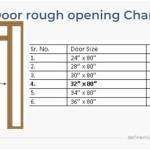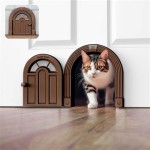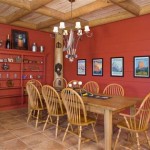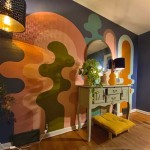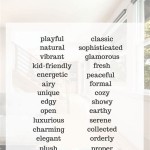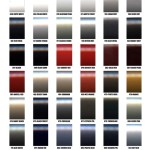How To Figure Out Your Interior Design Style
Identifying one's interior design style can seem daunting. The vast array of options presented through magazines, online platforms, and retail spaces can lead to confusion rather than clarity. However, with a structured approach and a willingness to explore personal preferences, it is possible to define an aesthetic that resonates with individual needs and tastes. This article will provide a comprehensive guide to navigating the process of discovering one's interior design style.
The first step involves understanding that interior design style is not a monolithic entity. It is a spectrum of influences blended to create a cohesive and aesthetically pleasing environment. Style can be influenced by historical periods, geographical locations, artistic movements, and personal experiences. It is often a hybrid, borrowing elements from multiple sources to achieve a unique and personalized result. Recognizing this complexity is crucial to avoiding limiting oneself to a single, rigidly defined category.
Many individuals struggle with identifying their style because they attempt to mimic what they see in idealized settings without considering their own lifestyles and practical requirements. A design style, however visually appealing, will ultimately fail if it does not complement the way a person lives and interacts with the space. Therefore, a critical aspect of this process involves an honest assessment of one's daily routines, activities, and storage needs. It requires recognizing what brings comfort, functionality, and joy within the home.
Analyzing Existing Preferences and Possessions
One of the most effective methods for uncovering one's design preferences is to examine existing clothing, artwork, and décor items. The choices already made often reveal underlying preferences that may not be consciously recognized. Consider the dominant colors present in the wardrobe. Are they neutral and muted, or bold and vibrant? Do the clothing styles tend towards classic and tailored, or relaxed and bohemian? These preferences often translate directly into desired color palettes and design aesthetics for the home.
Similarly, analyze existing artwork and decorative objects. What are the recurring themes, materials, and textures? Does one gravitate towards abstract paintings, landscape photography, or minimalist sculptures? Do items tend to be handcrafted and artisanal, or mass-produced and modern? The answers to these questions provide valuable insights into preferred artistic styles and design sensibilities. The materials and finishes of existing furniture pieces can also be telling. Are there preferences for natural wood, sleek metal, plush upholstery, or durable synthetics? These choices highlight potential inclinations towards specific design styles.
Consider the emotional connection to these existing items. Which pieces evoke feelings of comfort, happiness, or inspiration? Are there specific items that one particularly dislikes or finds visually jarring? Identifying the reasons behind these positive and negative reactions can further refine one's understanding of personal style. For instance, an aversion to overly ornate details might suggest a preference for simpler, more streamlined designs. Whereas a fondness for vintage furniture could indicate an affinity for traditional or eclectic styles.
Beyond physical possessions, consider the spaces one finds most appealing. This could include favorite cafes, hotels, or even the homes of friends and family. Analyzing the design elements of these spaces can reveal underlying aesthetic preferences. Pay attention to the lighting, furniture arrangements, color schemes, and overall atmosphere of these environments. What specific aspects resonate most strongly, and why?
Exploring Different Interior Design Styles
Once a foundation of personal preferences has been established, the next step involves exploring the diverse range of established interior design styles. This exploration should encompass a broad spectrum, from classic to contemporary, and from minimalist to maximalist. The aim is not to adhere rigidly to any single style, but rather to identify elements that appeal and can be incorporated into a personalized aesthetic. Detailed research is essential, utilizing resources such as books, magazines, and online platforms.
Familiarize oneself with the key characteristics of popular styles such as:
Modern:
Characterized by clean lines, minimalist décor, and a focus on functionality. Often incorporates neutral color palettes, geometric shapes, and a mix of natural and synthetic materials.Contemporary:
A constantly evolving style that reflects current design trends. Often features open floor plans, large windows, and a focus on natural light. Colors tend to be neutral with pops of accent colors.Traditional:
Inspired by historical periods, often incorporating ornate details, rich colors, and classic furniture styles. Common features include patterned fabrics, antique pieces, and formal arrangements.Minimalist:
Emphasizes simplicity and functionality, with a focus on essential elements and uncluttered spaces. Relies on neutral colors, clean lines, and a limited number of decorative items.Bohemian:
Embraces a free-spirited and eclectic aesthetic, incorporating a mix of textures, patterns, and colors. Often features vintage furniture, global textiles, and natural elements.Industrial:
Inspired by factories and warehouses, often incorporating exposed brick, concrete floors, and metal accents. Features a raw and unfinished aesthetic with a focus on functionality.Scandinavian:
Emphasizes simplicity, functionality, and natural light. Characterized by neutral colors, natural materials, and a cozy atmosphere.Transitional:
A blend of traditional and contemporary styles, creating a balanced and harmonious aesthetic. Incorporates classic furniture shapes with modern fabrics and finishes.
As one explores these different styles, create a visual library by saving images that resonate aesthetically. This could involve creating a mood board, either physical or digital, that showcases preferred colors, textures, furniture styles, and decorative elements. The purpose of this exercise is not to replicate an existing style, but rather to identify the specific elements that appeal and can be combined in unique ways.
Pay close attention to the architectural features of the home when exploring different styles. Certain styles may be more suited to specific architectural types. For example, a modern style may complement a minimalist, open-plan home, while a traditional style might suit a Victorian or colonial-style house. While architectural constraints should be considered, they should not entirely dictate the design style. It is possible to adapt and personalize any style to suit the existing architecture.
Prioritizing Functionality and Lifestyle
Before committing to a particular design style, it is crucial to consider the practical requirements of the space and the lifestyle of the occupants. A visually stunning design will ultimately fail if it does not meet the functional needs of the people who live there. This involves an honest assessment of daily routines, storage needs, and lifestyle activities. The goal is to create a space that is both aesthetically pleasing and highly functional.
Consider the specific needs of each room. A living room designed for frequent entertaining will require different furniture arrangements and seating options than a living room used primarily for relaxation. A kitchen designed for avid cooks will need ample counter space, specialized storage, and durable materials. A bedroom should prioritize comfort and relaxation, with a focus on restful colors and comfortable bedding.
Evaluate storage needs carefully. A well-designed space incorporates ample storage to minimize clutter and maximize functionality. This may involve incorporating built-in shelves, hidden storage compartments, or multi-functional furniture pieces. Consider the types of items that need to be stored and the frequency with which they are used. This will help determine the most efficient and accessible storage solutions. A minimalist style may require more clever storage solutions to maintain its uncluttered aesthetic.
Think about the impact of children or pets on the design. Homes with young children or pets may require more durable materials, easier-to-clean surfaces, and child- or pet-friendly furniture arrangements. Opt for fabrics that are stain-resistant and easy to clean. Choose furniture with rounded edges and sturdy construction. Consider using rugs and carpets that are durable and washable. A bohemian style with its layered textures and patterns can be more forgiving of wear and tear than a minimalist or modern style.
Finally, consider the long-term maintenance and upkeep of the chosen design style. Some styles may require more frequent cleaning and maintenance than others. For example, a traditional style with ornate details and delicate fabrics may require more specialized cleaning than a modern style with simple lines and durable materials. Be realistic about the time and effort one is willing to invest in maintaining the space. Selecting durable, low-maintenance materials can significantly reduce the burden of upkeep.

How To Figure Out What S My Design Style Worthing Court

Dear Urbaneer How Do We Establish Our Interior Design Style

How To Find Your Unique Personal Interior Design Style Dwell Beautiful

How To Choose An Interior Design Style The Beauty Revival

Find Your Interior Design Style Quiz Southern Motion

A Guide To Interior Design Styles How Find Your Unique Home Decor Style Primer

What S Your Interior Design Style

Why Is It Important To Determine Your Design Style Cristina Isabel

How To Find Your Personal Decor Style The Everygirl

How To Find Your Design Style The Havenly Blog Interior
Related Posts

